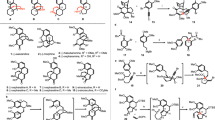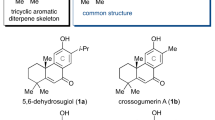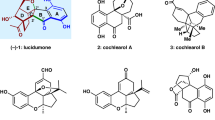Abstract
Tubingensin B is an indole diterpenoid that bears a daunting chemical structure featuring a disubstituted carbazole unit, five stereogenic centres—three of which are quaternary—and a decorated [3.2.2]-bridged bicycle. We describe our synthetic design toward a concise and enantiospecific total synthesis of tubingensin B, which hinges on the strategic use of a transient aryne intermediate. Although initial studies led to unexpected reaction outcomes, we ultimately implemented a sequence of carbazolyne cyclization followed by Rh-catalysed fragmentation to install the seven-membered ring and vicinal quaternary stereocentres of the natural product. Coupled with a late-stage radical cyclization to construct the [3.2.2]-bridged bicycle, these efforts have enabled the total synthesis of tubingensin B. The design and evolution of our succinct total synthesis underscores the utility of long-avoided aryne intermediates for the introduction of structural motifs that have conventionally been viewed as challenging.
This is a preview of subscription content, access via your institution
Access options
Access Nature and 54 other Nature Portfolio journals
Get Nature+, our best-value online-access subscription
$29.99 / 30 days
cancel any time
Subscribe to this journal
Receive 12 print issues and online access
$259.00 per year
only $21.58 per issue
Buy this article
- Purchase on Springer Link
- Instant access to full article PDF
Prices may be subject to local taxes which are calculated during checkout





Similar content being viewed by others
References
TePaske, M. R., Gloer, J. B., Wicklow, D. T. & Dowd, P. F. The structure of tubingensin B: a cytotoxic carbazole alkaloid from the sclerotia of Aspergillus tubingensis. Tetrahedron Lett. 30, 5965–5968 (1989).
Swenson, D. C., TePaske, M. R., Baenziger, N. C. & Gloer, J. B. Tubingensin B, a cytotoxic carbazole alkaloid from the sclerotia of Aspergillus tubingensis. Acta Cryst. C 53, 1447–1449 (1997).
Bian, M. et al. Total synthesis of anominine and tubingensin A. J. Am. Chem. Soc. 134, 8078–8081 (2012).
Goetz, A. E., Silberstein, A. L., Corsello, M. A. & Garg, N. K. Concise enantiospecific total synthesis of tubingensin A. J. Am. Chem. Soc. 136, 3036–3039 (2014).
Goetz, A. E., Shah, T. K. & Garg, N. K. Pyridynes and indolynes as building blocks for functionalized heterocycles and natural products. Chem. Commun. 51, 34–45 (2015).
Tadross, P. M. & Stoltz, B. M. A comprehensive history of arynes in natural product total synthesis. Chem. Rev. 112, 3550–3577 (2012).
Boente, J. M. et al. Oxocompostelline and oxocularine, structure and synthesis. Tetrahedron Lett. 24, 2295–2298 (1983).
Huters, A. D., Quasdorf, K. W., Styduhar, E. D. & Garg, N. K. Total synthesis of (–)-N-methylwelwitindolinone C isothiocyanate. J. Am. Chem. Soc. 133, 15797–15799 (2011).
Skorobogatyi, M. V. et al. 5-Arylethynyl-2´-deoxyuridines, compounds active against HSV-1. Org. Biomol. Chem. 4, 1091–1096 (2006).
Tummatorn, J. & Dudley, G. B. Generation of medium-ring cycloalkynes by ring expansion of vinylogous acyl triflates. Org. Lett. 13, 1572–1575 (2011).
Gulías, M., Durán, J., López, F., Castedo, L. & Mascareñas, J. L. Palladium-catalyzed [4+3] intramolecular cycloaddition of alkylidenecyclopropanes and dienes. J. Am. Chem. Soc. 129, 11026–11027 (2007).
Freeman, F. & Robarge, K. D. Stereoselectivity in electrophile-mediated intramolecular cyclizations of hept-2-enitols. J. Org. Chem. 54, 346–359 (1989).
White, J. D., Grether, U. M. & Lee, C.-S. (R)-(+)-3,4-Dimethylcyclohex-2-en-1-one. Org. Synth. 82, 108–114 (2005).
Kojima, A., Honzawa, S., Boden, C. D. J. & Shibasaki, M. Tandem Suzuki cross-coupling-Heck reactions. Tetrahedron Lett. 38, 3455–3458 (1997).
Dudley, G. B., Tan, D. S., Kim, G., Tanski, J. M. & Danishefsky, S. J. Remarkable stereoselectivity in the alkylation of a hydroazulenone: progress towards the total synthesis of guanacastepene. Tetrahedron Lett. 42, 6789–6791 (2001).
Schwartz, B. D., Denton, J. R., Lian, Y., Davies, H. W. L. & Williams, C. M. Asymmetric [4+3] cycloadditions between vinylcarbenoids and dienes: application to the total synthesis of the natural product (−)-5-epi-vibsanin E. J. Am. Chem. Soc. 131, 8329–8332 (2009).
Caubere, P. Applications of sodamide-containing complex bases in organic synthesis. Acc. Chem. Res. 7, 301–308 (1974).
Gregoire, B., Carre, M.-C. & Caubere, P. Arynic condensation of ketone enolates. 17. New general access to benzocyclobutene derivatives. J. Org. Chem. 51, 1419–1427 (1986).
Legault, C. Y. CYLview v. 1.0b (Université de Sherbrooke, 2009); http://www.cylview.org
Lipomi, D. J., Langille, M. F. & Panek, J. S. Total synthesis of basiliskamides A and B. Org. Lett. 6, 3533–3536 (2004).
Szpilman, A. M., Cereghetti, D. M., Wurtz, N. R., Manthorpe, J. M. & Carreira, E. M. Synthesis of 35-deoxy amphotericinB methyl ester: a strategy for molecular editing. Angew. Chem. Int. Ed. 47, 4335–4338 (2008).
Uyehara, T., Murayama, T., Sakai, K., Ueno, M. & Sato, T. Formal substitution at both bridgeheads of a bicyclo[2.2.2]oct-5-en-2-one and its application to a synthesis of (±)-modhephene. Tetrahedron Lett. 37, 7295–7298 (1996).
Uyehara, T. et al. Rearrangement approaches to cyclic skeletons. XIII. Total synthesis of triquinane sesquiterpenes, (±)-modhephene and (±)-isocomene, on the basis of formal substitution at both bridgeheads of a bicyclo[2.2.2]-oct-5-en-2-one. Bull. Chem. Soc. Jpn 71, 231–242 (1998).
Tang, W. & Zhang, X. New chiral phosphorus ligands for enantioselective hydrogenation. Chem. Rev. 103, 3029–3069 (2003).
Tranchier, J.-P., Ratovelomanana-Vidal, V., Genêt, J.-P., Tong, S. & Cohen, T. Asymmetric hydrogenation of phenylthio ketones with chiral Ru(II) catalysts. Tetrahedron Lett. 38, 2951–2954 (1997).
Reich, H. J., Chow, F. & Shah, S. K. Selenium stabilized carbanions. Preparation of α-lithio selenides and applications to the synthesis of olefins by reductive elimination of β-hydroxy selenides and selenoxide syn elimination. J. Am. Chem. Soc. 101, 6638–6648 (1979).
Ishida, N., Sawano, S., Masuda, Y. & Murakami, M. Rhodium-catalyzed ring opening of benzocyclobutenols with site-selectivity complementary to thermal ring opening. J. Am. Chem. Soc. 134, 17502–17504 (2012).
Clive, D. L. J., Cole, D. C. & Tao, Y. Formation of angularly-fused triquinanes by successive use of the Pauson–Khand reaction and radical closure. J. Org. Chem. 59, 1396–1406 (1994).
Acknowledgements
The authors are grateful to the NIH-NIGMS (R01 GM090007 to N.K.G.), the Dreyfus Foundation, the UCLA Gold Shield Alumnae, the National Science Foundation Graduate Research Fellowship Program (DGE-1144087 to M.A.C.) and the University of California, Los Angeles for financial support. We thank Y. Tang (University of California, Los Angeles) for an authentic sample of tubingensin B. These studies were also supported by shared instrumentation grants from the NSF (no. CHE-1048804) and the National Center for Research Resources (no. S10RR025631).
Author information
Authors and Affiliations
Contributions
M.A.C. and J.K. designed and performed experiments and analysed experimental data. N.K.G. directed the investigations and prepared the manuscript with contributions from all authors; all authors contributed to discussions.
Corresponding author
Ethics declarations
Competing interests
The authors declare no competing financial interests.
Supplementary information
Supplementary information
Supplementary information (PDF 2760 kb)
Rights and permissions
About this article
Cite this article
Corsello, M., Kim, J. & Garg, N. Total synthesis of (–)-tubingensin B enabled by the strategic use of an aryne cyclization. Nature Chem 9, 944–949 (2017). https://doi.org/10.1038/nchem.2801
Received:
Accepted:
Published:
Issue Date:
DOI: https://doi.org/10.1038/nchem.2801
This article is cited by
-
Asymmetric reactions involving aryne intermediates
Nature Reviews Chemistry (2023)
-
Facile generation of bridged medium-sized polycyclic systems by rhodium-catalysed intramolecular (3+2) dipolar cycloadditions
Nature Communications (2021)




